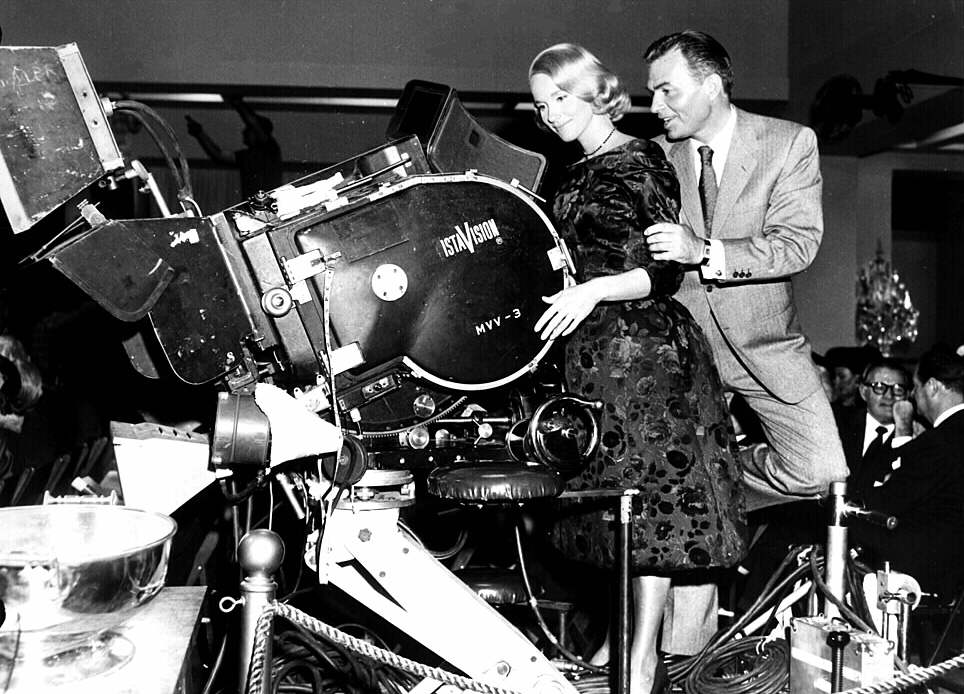Prepare to be mesmerized as we delve into the captivating cinematic world of Alfred Hitchcock through the lens of VistaVision. This innovative film format, with its unparalleled clarity and widescreen grandeur, became a defining element in four of Hitchcock’s most celebrated works: “To Catch a Thief,” “The Man Who Knew Too Much,” “Vertigo,” and “North by Northwest.” Hitchcock’s mastery of VistaVision transformed the cinematic landscape, forever etching these films into the annals of cinema history. But VistaVision’s significance extends beyond mere technical achievement; it represents a pivotal period of artistic innovation in Hitchcock’s career. Join us as we explore the legacy of these collaborations, where visual artistry and storytelling brilliance intertwine to create a cinematic feast for the eyes.
VistaVision: A New Era of Cinematic Grandeur
VistaVision, a widescreen film format developed by Paramount Pictures in 1954, emerged as a response to the growing threat of television. It promised, and delivered, a superior cinematic experience. Utilizing a horizontal film transport, VistaVision captured images with twice the standard resolution of 35mm film, resulting in breathtaking clarity and detail ideal for large-screen projection. This technical innovation did not go unnoticed by Alfred Hitchcock, a director celebrated for his meticulous compositions and ability to build suspense through visual storytelling. While “White Christmas” (1954) holds the distinction of being the first film shot entirely in VistaVision, it was Hitchcock who would truly push the format’s boundaries, ushering in a new era of cinematic grandeur.
Hitchcock’s VistaVision Era: From the Riviera to Mount Rushmore
Between 1955 and 1959, four of Hitchcock’s most iconic films were lensed in VistaVision, each showcasing the format’s remarkable capacity for both spectacle and psychological depth:
- “To Catch a Thief” (1955): Set against the sun-drenched beauty of the French Riviera, this stylish thriller, starring Cary Grant and Grace Kelly, positively shimmers in VistaVision. The format’s superior color reproduction brings the azure waters and vibrant landscapes to life, immersing viewers in a world of glamour and intrigue.
- “The Man Who Knew Too Much” (1956): Hitchcock’s remake of his own 1934 film, starring James Stewart and Doris Day, utilizes VistaVision to heighten the suspense of this globe-trotting thriller. The format’s clarity is evident in the film’s iconic set pieces, including a heart-stopping climax at London’s Royal Albert Hall.
- “Vertigo” (1958): Often considered Hitchcock’s masterpiece, “Vertigo” reveals the psychological potential of VistaVision. The film’s haunting beauty, dreamlike atmosphere, and James Stewart’s descent into obsession are all heightened by the format’s ability to capture subtle shifts in expression and create a palpable sense of unease.
- “North by Northwest” (1959): This quintessential Hitchcockian thriller, starring Cary Grant, demonstrates the epic scale VistaVision could achieve. From the vast cornfields of the Midwest to the iconic climax on Mount Rushmore, the film utilizes the format’s widescreen canvas to create unforgettable imagery and breathtaking suspense. Notably, “North by Northwest” was produced by MGM, demonstrating VistaVision’s appeal beyond its studio of origin, Paramount.
Beyond the Spectacle: VistaVision’s Impact on Hitchcock’s Style
While VistaVision undeniably enhanced the visual splendor of Hitchcock’s films, its impact runs deeper than mere spectacle. The format became an integral tool for amplifying the director’s signature style:
- Heightened Suspense: VistaVision’s clarity and detail allowed Hitchcock to capture even the subtlest of facial expressions, gestures, and visual cues. This amplified the director’s mastery of suspense, as viewers were able to better perceive the fear, uncertainty, and psychological turmoil of the characters.
- Visual Storytelling: The larger frame size provided by VistaVision facilitated more complex compositions. Hitchcock, a master of visual storytelling, used this expanded canvas to convey narrative information and psychological depth through subtle visual details, innovative camera movements, and the interplay of light and shadow.
- Immersive Environments: VistaVision’s ability to present sweeping vistas and detailed close-ups with equal clarity enabled Hitchcock to create truly immersive cinematic experiences. Whether it’s the sun-drenched beauty of the Riviera in “To Catch a Thief” or the claustrophobic interiors of “Vertigo,” VistaVision brings a heightened sense of realism and immediacy to these settings.
The Legacy of VistaVision and Hitchcock’s Enduring Vision
Despite its advantages, VistaVision was ultimately a short-lived format. Its cost and the technical challenges of its implementation led to its decline in the late 1950s. However, its influence can be felt in the widescreen formats that followed, and its legacy lives on in the stunning clarity of Hitchcock’s films.
Today, the high-resolution negatives of Hitchcock’s VistaVision masterpieces have made them ideal candidates for digital restoration. These restorations allow modern audiences to experience these films as they were intended to be seen – in all their widescreen glory, with a level of detail and clarity that rivals, and often surpasses, contemporary productions.
Alfred Hitchcock’s embrace of VistaVision reveals a director committed to pushing the boundaries of cinematic storytelling. By harnessing the format’s technical advantages, Hitchcock elevated his signature style, crafting a quartet of films that continue to captivate and enthrall audiences decades later. The enduring legacy of these collaborations reminds us that true cinematic innovation lies not just in technological advancement, but in the artistry and vision of those who wield it.
What was the first movie filmed in VistaVision?
The very first movie to be filmed in the revolutionary VistaVision format was “White Christmas,” the beloved 1954 musical starring Bing Crosby, Danny Kaye, Rosemary Clooney, and Vera-Ellen. The film’s festive musical numbers and heartwarming story, presented in stunning clarity and vibrant color, likely captivated audiences, showcasing the format’s potential for both spectacle and emotional resonance.
What was the last movie in VistaVision?
While VistaVision faded from popularity in the late 1950s, its exceptional resolution kept it relevant for special effects work in films like “Star Wars” (1977) and “Jurassic Park” (1993). The last American feature film shot entirely in VistaVision is generally considered to be “One-Eyed Jacks” (1961), a Western directed by and starring Marlon Brando. Interestingly, VistaVision had a later resurgence in Japan, with “The End of Evangelion” (1997), a popular anime film, being the last internationally released production shot using the format. Intriguingly, the upcoming film “The Brutalist” (2024) also reportedly used VistaVision, suggesting a potential revival for this classic format among contemporary filmmakers.
Which is the only Alfred Hitchcock film to be shot in 3D?
Alfred Hitchcock, though renowned for his visual style, was not one to simply follow trends. While 3D was in vogue in the early 1950s, he approached the technology with caution. The only film in his filmography to employ the process is “Dial M for Murder” (1954), a suspenseful thriller starring Grace Kelly and Ray Milland. Rather than utilizing 3D for cheap thrills, Hitchcock saw it as a means to enhance the film’s claustrophobic atmosphere and heighten the psychological tension within the confines of a single apartment setting.
What was the first Alfred Hitchcock film shot in Technicolor?
Ever the innovator, Alfred Hitchcock embraced color filmmaking with “Rope” (1948), a suspenseful thriller that marked his first foray into Technicolor. The film, starring James Stewart, John Dall, and Farley Granger, is notable for its technical achievements and Hitchcock’s experimentation with long takes and a restricted setting. Hitchcock recognized that color could be more than just an aesthetic enhancement; it could serve as a powerful tool for storytelling, amplifying emotions, establishing mood, and adding layers of meaning to the mise-en-scène. The move to Technicolor proved pivotal in Hitchcock’s career, ushering in a new era of visual richness and solidifying his reputation as a master of visual storytelling.

![Of Silver Screens and Time: A Historical Timeline of Cinema's Evolution [history of cinema timeline] history-of-cinema-timeline_2](https://www.lolaapp.com/wp-content/uploads/2023/12/history-of-cinema-timeline_2-150x150.jpg)















4 thoughts on “Hitchcock & VistaVision: Unveiling the Master’s Widescreen Vision”
Comments are closed.